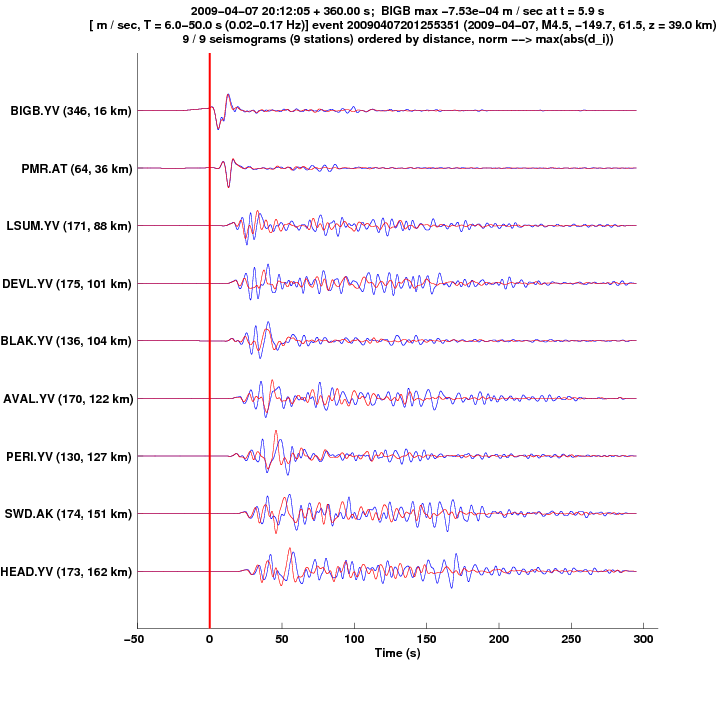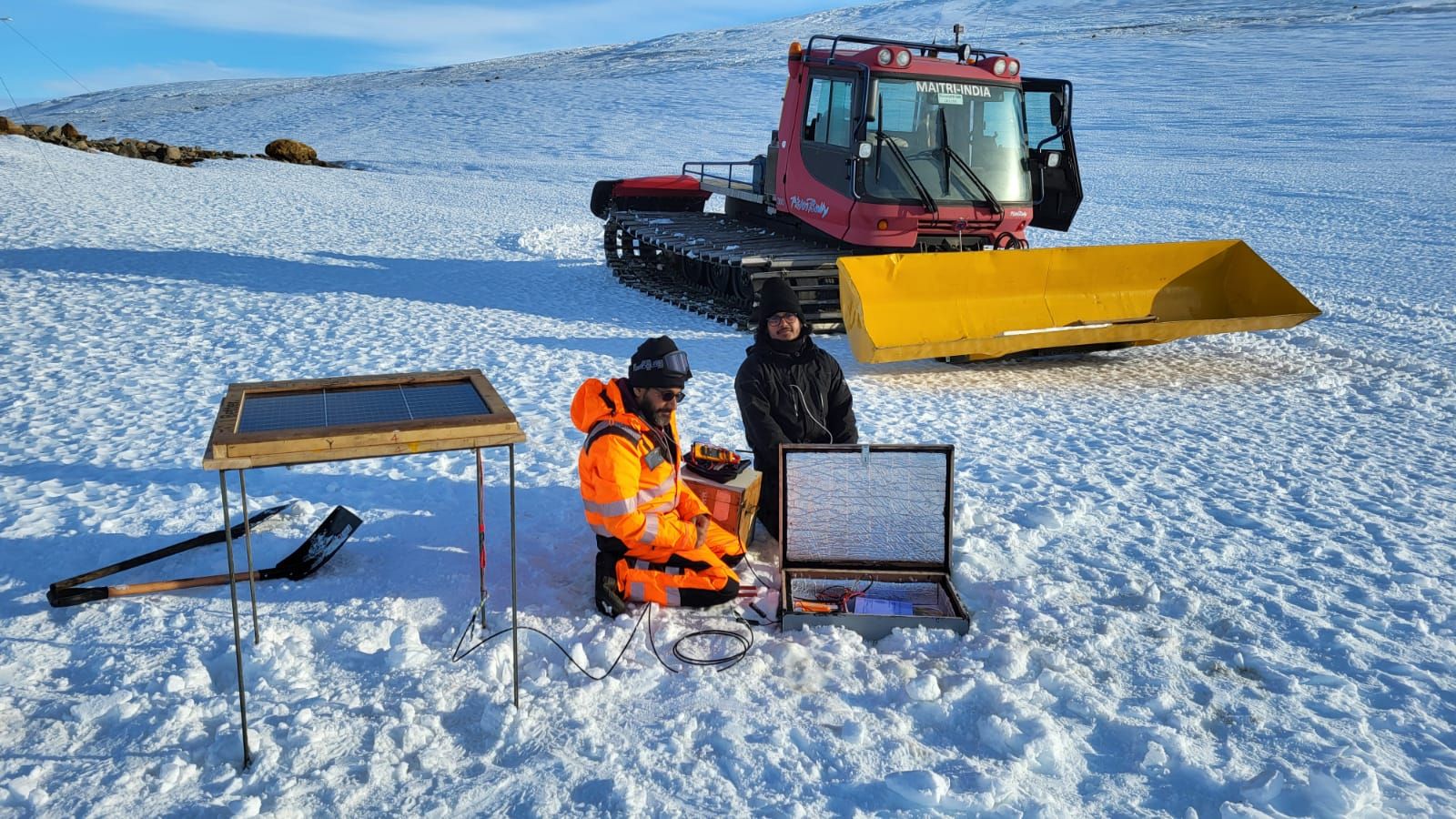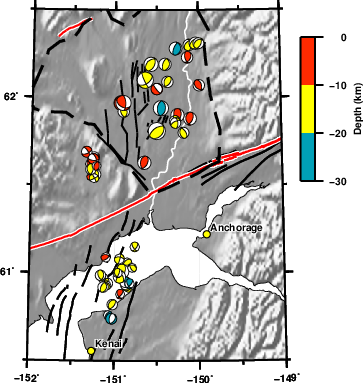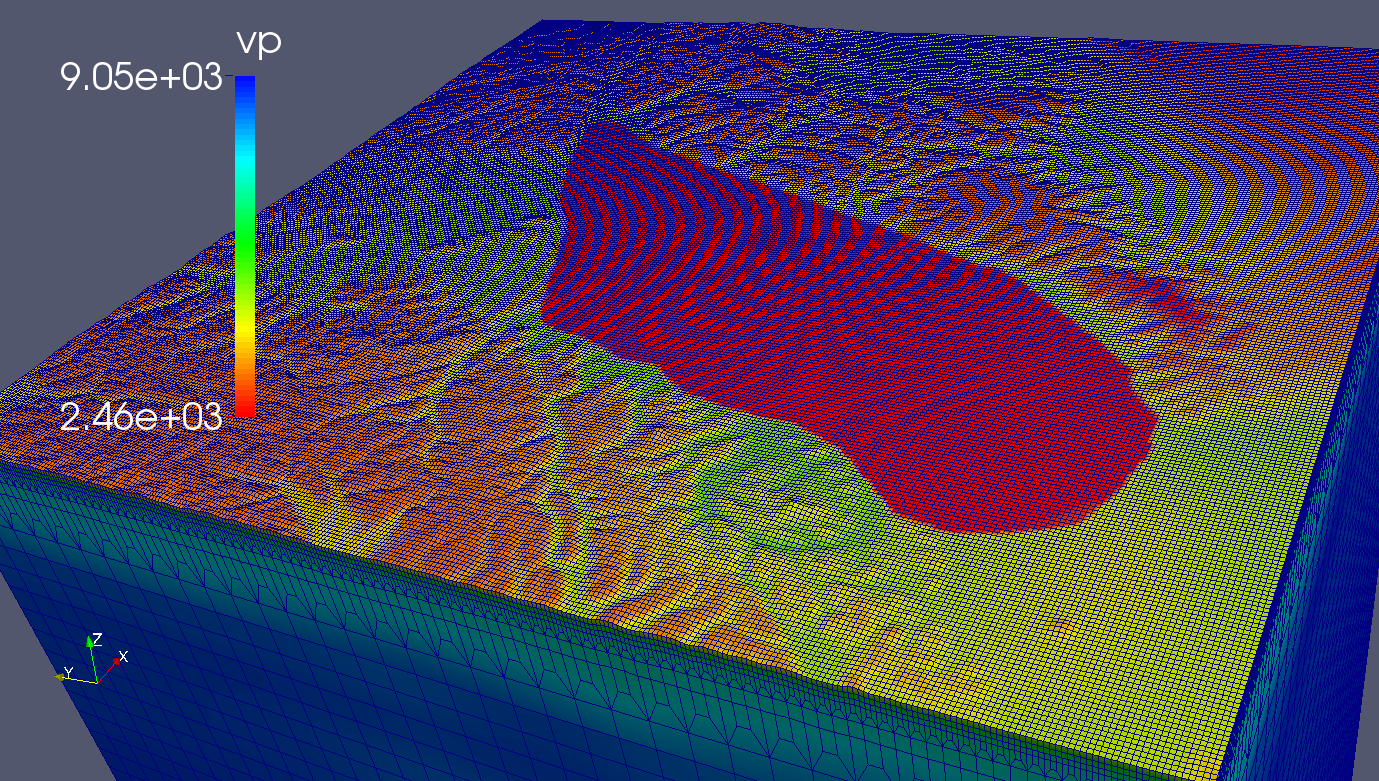Broadly speaking, my research interests can be classified into two subcategories: (1) Earthquake source and (2) the Structure. Both of these go hand-in-hand, where understanding of one is impossible without the knowledge of the other.
3D numerical simulations
|
|
 Wavefield movie for an earthquake in southern Alaska showing effects (amplification) due to (low velocity) sedimentary basin. |
 Synthetic waveforms filtered between 6-50s computed with (blue) and without (red) embedding the Cook Inlet basin. |
References:
Silwal, V., C. Tape, and E. Casarotti, Wavefield Simulation of earthquakes in southern Alaska for tomographic inversion, AGU Fall Meeting 11-15 Dec. 2017, New Orleans
Silwal, V., et al., The 2023 MW 5.7 Nepal earthquake: Source mechanism and structural response of Indo-Gangetic basin (in Review)
Silwal, V., 2018, Earthquake source mechanisms and three-dimensional wavefield simulations in Alaska, PhD Thesis
Moment tensor inversions in
Himalayas
We prepare a moment tensor
catalog of >250 events (2007-2017) that are distributed
in Alaska and 40 earthquakes in Himalayas.Earthquakes in general occur on a fault by shear dislocation, which can be modeled as a double couple moment tensor. A double couple moment tensor is a 3 × 3 symmetric matrix whose eigenvalues are (λ, 0, −λ). We are concerned with estimating the magnitude and orientation (strike, dip, rake) of the moment tensor. Alternative terms for double couple moment tensors are ‘fault-plane solution’ or ‘focal mechanism.’ Our approach to moment tensor estimation can also be applied to ‘full’ moment tensors, which contain an additional two parameters (Alvizuri & Tape (2016)).
We perform moment tensor inversion using the ‘cut-and-paste’ (CAP) method of Zhu & Helmberger (1996). The best moment tensor is obtained by minimizing the difference between the data with the synthetics. The synthetics are computed for all possible moment tensors using a 1D reference structural model. Different bandpass filters are applied to the body waves and surface waves when comparing the data with the synthetics.


(left) Moment tensor and seismicity map of
Garhwal-Kumaon Himalayas.
(center) Waveform fits between data (black) and synthetics (red) for an event in Anchorage (2009-04-07). The 'x' marked on the beachball are the theoretical piercing points of the emerging ray path to the stations.
(center) Waveform fits between data (black) and synthetics (red) for an event in Anchorage (2009-04-07). The 'x' marked on the beachball are the theoretical piercing points of the emerging ray path to the stations.
(right)
Moment tensor and seismicity map of Alaska
References:
Mahanta, R., & Silwal, V. (2024). Moment tensor inversion and uncertainty analysis for 40 Uttarakhand Earthquakes (2010-2022) [Data set]. Zenodo. https://doi.org/10.5281/zenodo.12541669
Vipul Silwal, 2018, Seismic moment tensors for six events in Minto Flats fault zone, 2012-2016
Vipul Silwal, 2018, Seismic moment tensor catalog for crustal events in southern Alaska
Vipul Silwal, 2015, Seismic moment tensor catalog for southern Alaska
Vipul Silwal, 2015, Seismic moment tensor catalog for Minto Flats fault zone (2000-2014)
References:
- Kumar P, Silwal V*, Mahanta R, Maurya VK, Kamal, Sharma ML, Ammani A, (2023). Near Real-Time Detection and Moment Tensor Inversion of the 11 May 2022, Dharchula Earthquake. GeoHazards.vol 4(4):515-525. https://doi.org/10.3390/geohazards4040029.
- Mahanta, R., Silwal, V.*, Sharma, M.L. (2024). Body Waves– and Surface Waves–Derived Moment Tensor Catalog for Garhwal-Kumaon Himalayas. In: Kumar, R., Singh, R., Kanhaiya, S., Maurya, S.P. (eds) Recent Developments in Earthquake Seismology. Springer, Cham. https://doi.org/10.1007/978-3-031-47538-2_4
- Silwal, V. and C. Tape, 2016, Seismic moment tensors and estimated uncertainties in southern Alaska, Journal of Geophysical Research: Solid Earth, 121, 2772–2797, doi:10.1002/2015JB012588
- Silwal, V., C. Tape, and A. Lomax, 2018, Crustal earthquakes in the Cook Inlet and Susitna region of southern Alaska, Tectonophysics, doi:10.1016/j.tecto.2018.08.013
- Alvizuri, C., V. Silwal, L. Krischer, and C. Tape, 2018, Estimation of full moment tensors, including uncertainties, for nuclear explorsions, volcanic events, and earthquakes. Journal of Geophysical Research: Solid Earth, doi: 10.1029/2017jb015325
Mahanta, R., & Silwal, V. (2024). Moment tensor inversion and uncertainty analysis for 40 Uttarakhand Earthquakes (2010-2022) [Data set]. Zenodo. https://doi.org/10.5281/zenodo.12541669
Vipul Silwal, 2018, Seismic moment tensors for six events in Minto Flats fault zone, 2012-2016
Vipul Silwal, 2018, Seismic moment tensor catalog for crustal events in southern Alaska
Vipul Silwal, 2015, Seismic moment tensor catalog for southern Alaska
Vipul Silwal, 2015, Seismic moment tensor catalog for Minto Flats fault zone (2000-2014)
Cryoseismology

(left) one data of time series and detection using hybrid STA/LTA approach. (right) Installation in Antarctica.
Event detection using attentive deep learning
We have used an attention-based deep learning model for automatically detecting events, picking seismic phases and estimating magnitude. In this study, we also developed automated selection criteria to filter out the less reliable detection based on the probability of detection and picked phases; this saved lots of computational time when working with sizeable seismic data sets. Our deep learning based model was applied from January 2013 to October 2013, and we were able locate approximately 4.5 times more earthquakes than those in the ISC catalogue within a very short time. Magnitude estimation clearly shows that the attention deep learning model is quite efficient in detecting low magnitude and recurring events that were not previously detected by manual picking or other automated algorithms. Our model enhanced the region’s seismicity and could map several earthquakes along the neotectonic likely active faults of western Pamir, which further supports the western extrusion of Pamir rocks due to the collision of the Pamir Plateau in the Tajik Depression.
(left) Deep Learning model used for event detection (center) comparison STA/LTA and deep learning model model detected events. (right - Figure 4 of Singh and Silwal 2023) Close-up view of detected event shows the deep learning model is better at detecting events.
References:
Satyam Pratap Singh, Vipul Silwal*, 2023, Enhanced crustal and intermediate seismicity in the Hindu Kush-Pamir region revealed by attentive deep learning model, Artificial Intelligence in Geosciences, Volume 4, Pages 150-163.
Satyam Pratap Singh, Vipul Silwal*, 2023, Enhanced crustal and intermediate seismicity in the Hindu Kush-Pamir region revealed by attentive deep learning model, Artificial Intelligence in Geosciences, Volume 4, Pages 150-163.
Seismotectonics and Fault delineation
Distribution of similar mechanism faulting for earthquakes in a seismic zone can be used as a strong evidence for the presence of a fault(s). This is specially useful when faults are sub-surface or overlain by a layer of sediment as in a basin environment and there is no surface feature.
These studies are generally supplemented with earthquake relocation, gravity and magnetic measurements, and revisit historical catalogs to get a better perspective on tectonics at regional scale.


(right) Consistent thrust faulting mechanism for small-to-intermediate magnitude earthquakes around Cook Inlet and Susitna basin, Alaska.
References:
Tape, C., V. Silwal, C. Ji, L. Keyson, M. E. West, and N. Ruppert, 2015, Transtensional Tectonics of the Minto Flats Fault Zone and Nenana Basin, Central Alaska, Bulletin of the Seismological Society of America, Vol. 105, No. 4, pp. 2081–2100, August 2015, doi: 10.1785/0120150055
Silwal, V., C. Tape, and A. Lomax, Crustal earthquakes in the Cook Inlet and Susitna region of southern Alaska (submitted to Tectonophysics).
